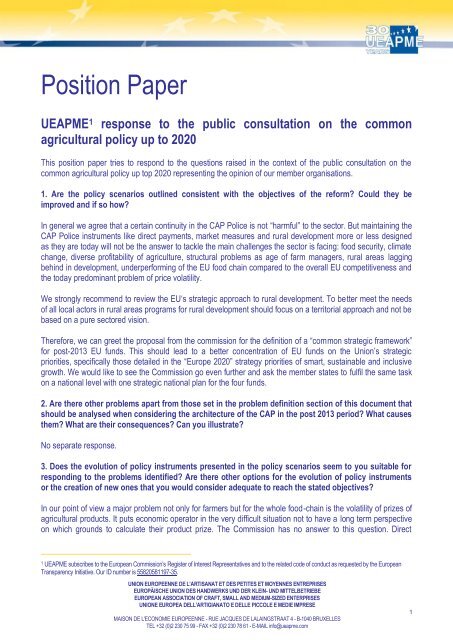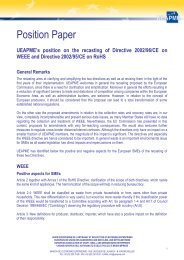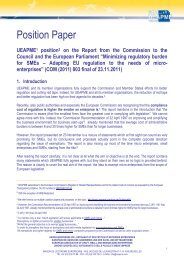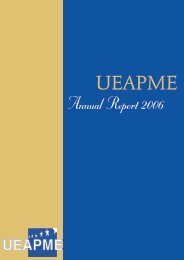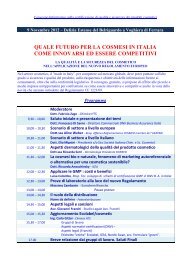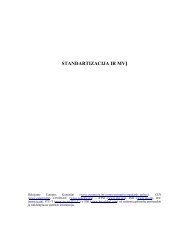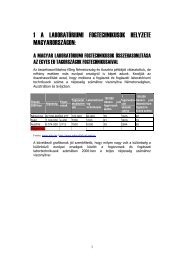Position Paper - UEAPME
Position Paper - UEAPME
Position Paper - UEAPME
Create successful ePaper yourself
Turn your PDF publications into a flip-book with our unique Google optimized e-Paper software.
<strong>Position</strong> <strong>Paper</strong><br />
<strong>UEAPME</strong> 1 response to the public consultation on the common<br />
agricultural policy up to 2020<br />
This position paper tries to respond to the questions raised in the context of the public consultation on the<br />
common agricultural policy up top 2020 representing the opinion of our member organisations.<br />
1. Are the policy scenarios outlined consistent with the objectives of the reform? Could they be<br />
improved and if so how?<br />
In general we agree that a certain continuity in the CAP Police is not “harmful” to the sector. But maintaining the<br />
CAP Police instruments like direct payments, market measures and rural development more or less designed<br />
as they are today will not be the answer to tackle the main challenges the sector is facing: food security, climate<br />
change, diverse profitability of agriculture, structural problems as age of farm managers, rural areas lagging<br />
behind in development, underperforming of the EU food chain compared to the overall EU competitiveness and<br />
the today predominant problem of price volatility.<br />
We strongly recommend to review the EU„s strategic approach to rural development. To better meet the needs<br />
of all local actors in rural areas programs for rural development should focus on a territorial approach and not be<br />
based on a pure sectored vision.<br />
Therefore, we can greet the proposal from the commission for the definition of a “common strategic framework”<br />
for post-2013 EU funds. This should lead to a better concentration of EU funds on the Union‟s strategic<br />
priorities, specifically those detailed in the “Europe 2020” strategy priorities of smart, sustainable and inclusive<br />
growth. We would like to see the Commission go even further and ask the member states to fulfil the same task<br />
on a national level with one strategic national plan for the four funds.<br />
2. Are there other problems apart from those set in the problem definition section of this document that<br />
should be analysed when considering the architecture of the CAP in the post 2013 period? What causes<br />
them? What are their consequences? Can you illustrate?<br />
No separate response.<br />
3. Does the evolution of policy instruments presented in the policy scenarios seem to you suitable for<br />
responding to the problems identified? Are there other options for the evolution of policy instruments<br />
or the creation of new ones that you would consider adequate to reach the stated objectives?<br />
In our point of view a major problem not only for farmers but for the whole food-chain is the volatility of prizes of<br />
agricultural products. It puts economic operator in the very difficult situation not to have a long term perspective<br />
on which grounds to calculate their product prize. The Commission has no answer to this question. Direct<br />
___________________________<br />
1 <strong>UEAPME</strong> subscribes to the European Commission‟s Register of Interest Representatives and to the related code of conduct as requested by the European<br />
Transparency Initiative. Our ID number is 55820581197-35.<br />
UNION EUROPEENNE DE L’ARTISANAT ET DES PETITES ET MOYENNES ENTREPRISES<br />
EUROPÄISCHE UNION DES HANDWERKS UND DER KLEIN- UND MITTELBETRIEBE<br />
EUROPEAN ASSOCIATION OF CRAFT, SMALL AND MEDIUM-SIZED ENTERPRISES<br />
UNIONE EUROPEA DELL’ARTIGIANATO E DELLE PICCOLE E MEDIE IMPRESE<br />
MAISON DE L'ECONOMIE EUROPEENNE - RUE JACQUES DE LALAINGSTRAAT 4 - B-1040 BRUXELLES<br />
TEL +32 (0)2 230 75 99 - FAX +32 (0)2 230 78 61 - E-MAIL info@ueapme.com<br />
1
payments and other income support may help the farmer but how can economic operators prevent?<br />
4. What do you see as the most significant impacts of the reform scenarios and the related options for<br />
policy instruments? Which actors would be particularly affected if these were put in place?<br />
An integrated territorial approach to rural development would better help to meet the strategic priorities of<br />
EUROPE 2020 - smart, sustainable and inclusive growth. All actors in the rural areas would better benefit. A<br />
Police for rural areas must take into consideration the needs of not only the agricultural population but of all<br />
groups like entrepreneurs, employees, families, elder people, young people etc. Efficient approaches to<br />
promoting rural development cannot be-discriminatory across sectors. Life-Quality in a rural area is not only<br />
defined by the number of farmers and ha. of cultivated farmland but more over of many different aspects of daily<br />
life: public infrastructure (kindergarten, schools etc.), food shops, possibilities for leisure and entertainment<br />
activities, the possibility to choose a job in different sectors etc.<br />
The three levels of players in rural areas as agricultural, non- agricultural and public sector activities should all<br />
be taken into consideration.<br />
In the running period of the program for rural development only a very few countries choose to broaden their<br />
approach and implemented measures like support for business creation and development, .Only about 2% of<br />
the total expenditure is directed to this measure in the EU. Surprisingly most of the new member states have<br />
made much more use of this measure.<br />
In our opinion this is the crucial point how to adopt a new approach to rural development. We need a clear<br />
commitment from the commission to see rural development policy also as policy for a vital development of the<br />
whole economy in rural areas. In this sense we are very doubtful that things will change in the new period after<br />
2013 if the commission will not put a more stringent objective to measures where agriculture is not the primarily<br />
beneficiary.<br />
5. To what extent will the strengthening of producer and inter-branch organizations and better access<br />
to risk management tools help improve farmers’ income levels and stability?<br />
No separate response.<br />
6. What environmental and climate-change benefits would you expect from the environment-targeted<br />
payments in the first and the second pillar of the CAP?<br />
The aim of these direct payments would be to ensure that the impact of companies in both pillars of the CAP on<br />
the environment and climate change in their area is improved. Therefore in principle there would be no reason<br />
to limit direct payments to companies of one of the two pillars.<br />
However, it has to be questioned how it is possible to check that these direct payments, made through public<br />
money, are really used by first and second pillar companies to ensure environmental and climate change<br />
benefits. It is clear that it is not possible for public authorities to carry out regular checks on all companies .<br />
Therefore, there might be a very high risks of frauds linked to this practice.<br />
7. What opportunities and difficulties do you see arising from a significant increase of the rural<br />
development budget and a reinforcement of strategic targeting?<br />
See answer to question 4. New opportunities could arise for strengthening measures to help to reinforce<br />
cooperation between farmers and economic operators especially smaller food processing companies. Measures<br />
in the program for rural development specially designed for the needs of such cooperation could very much<br />
MAISON DE L'ECONOMIE EUROPEENNE - RUE JACQUES DE LALAINGSTRAAT 4 - B-1040 BRUXELLES<br />
TEL +32 (0)2 230 75 99 - FAX +32 (0)2 230 78 61 - E-MAIL info@ueapme.com<br />
2
contribute to sustainable growth in small local areas.<br />
8. What would be the most significant impacts of a "no policy" scenario on the competitiveness of the<br />
agricultural sector, agricultural income, environment and territorial balance as well as public health?<br />
No separate response.<br />
9. What difficulties would the options analysed be likely to encounter if they were implemented, also<br />
with regard to control and compliance? What could be the potential administrative costs and burdens?<br />
No separate response.<br />
10. What indicators would best express the progress towards achieving the objectives of the reform?<br />
Create performance indicators linked to small and micro enterprises and to craft and non farming enterprises.<br />
11. Are there factors or elements of uncertainty that could significantly influence the impact of the<br />
scenarios assessed? Which are they? What could be their influence?<br />
No separate response.<br />
Brussels, 25 January 2011<br />
For further information on this position paper, please contact:<br />
Hubert Delorme, Senior Counsellor Regional Policy and cohesion of territories<br />
T. + 32 2 280 14043 / Email: h.delorme@ueapme.com<br />
Birte Day, Adviser Regional Policy and Cohesion of Territories<br />
T: + 32 2 230 7599 / Email: b.day@ueapme.com<br />
MAISON DE L'ECONOMIE EUROPEENNE - RUE JACQUES DE LALAINGSTRAAT 4 - B-1040 BRUXELLES<br />
TEL +32 (0)2 230 75 99 - FAX +32 (0)2 230 78 61 - E-MAIL info@ueapme.com<br />
3


